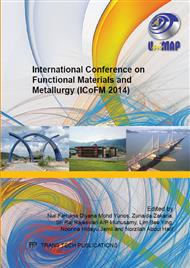p.417
p.423
p.429
p.437
p.443
p.449
p.455
p.461
p.467
Visual Inspection on Failure Surface of Constant Force Spring (CFS) Fitted in a Counterweight Balancing Mechanism
Abstract:
A failure characteristic of a fractured constant force spring (CFS) or flat spiral spring fitted in a counterweight balancing mechanism is investigated via series of visual experimentation. Macroscopic examination reveals several beach marks that shows direction of fatigue crack propagation has indicated that the CFS fracture had initiated and propagated due to fatigue from an inner surface origin. Macro cracks resulted from stress concentration were also visible on grain boundaries. The crack was initiated at the center of the CFS which later propagated in the direction perpendicular to the applied cyclic load and finally fractured when it can no longer sustain the applied cyclic load. Inspection via Scanning Electron Microscopy (SEM) has indicatedsign of fatigue striations perpendicular to the fracture propagation which is a characteristic of fatigue failure mechanism. Examination of the fractured surface also pointed porosities that reflects points of crack initiation. Multiple crack initiation points identified shows that the fracture was a result of high stress or high stress concentration.
Info:
Periodical:
Pages:
461-466
Citation:
Online since:
June 2015
Price:
Сopyright:
© 2015 Trans Tech Publications Ltd. All Rights Reserved
Share:
Citation:


